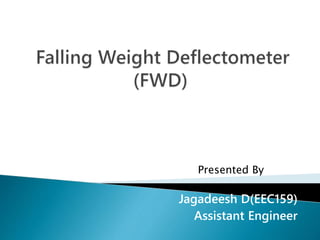
Falling weight deflection test
- 2. CONTENTS Introduction Structural Evaluation of FWD Comparison of BBD & FWD Principle of FWD Specifications of FWD Calibration of the FWD Pavement evaluation survey and data collection Analysis of field data Conclusion References
- 3. introduction Falling Weight Deflectometer (FWD) is an impulse-loading device in which a transient load is applied to the pavement and the deflected shape of the pavement surface is measured.
- 4. Structural Evaluation structural evaluation of pavements involves application of a standard load to the pavement and measuring its response in terms of stress, strain or deflection.
- 5. Comparison of BBD & FWD Benkelman beam has been among the earliest equipment used for measuring deflection. In this technique, a static load is applied to the pavement surface and rebound deflections are measured. Measurement of deflection under a static load does not simulate the loading conditions produced in pavements by a moving vehicle. And this method is labour-intensive & time consuming.
- 6. Principle of FWD The working principle of the FWD is a mass of weights is dropped from a pre-determined height onto a series of springs placed on top of a loading plate. The corresponding peak load and peak vertical surface deflections at different radial locations are measured.
- 7. Figure 1: Working principle of falling weight deflectometer
- 8. Specification of FWD As per IRC:115-2014
- 10. Battery box Fuse box
- 11. Battery box Mother Board
- 14. In FWD 6-9 geophones are generally adequate for measuring surface deflections of flexible pavement and this geophones have reading resolution of at least 1micron. S.NO Number of geophones Radial Distance from center of load plate (mm) 1 2 3 4 5 6 7 8 9 1 9 sensors 0 200 300 450 600 900 1200 1500 1800 2 7 sensors 0 300 600 900 1200 1500 1800 - - 3 7 sensors 0 200 300 450 600 900 1500 - - 4 6 sensors 0 300 600 900 1200 1500 - - - 5 6 sensors 0 200 300 600 900 1200 - - Table 1: Typical geophone position & Configuration
- 17. Calibration of the FWD The period of Static calibration is nearly 365 days The Standard deviation of the peak load in the load repeatability test estimated from a minimum of 12 load drops should be less than 5% of the mean value of peak load Absolute calibration of geophones are calibrated by the Stack test. The deflections produced in this test should be in the range of 250µm to 600µm.Difference between maximum and minimum of the recorded (normalized) deflections should be within 4µm
- 20. Pavement evaluation survey and data collection Historical data about pavement Pavement condition survey Deflection measurements using FWD
- 21. Historical data about pavement Historical data on pavement can be useful in identifying the reasons for different distresses and in establishing whether the distresses were caused by deficiency in design, poor material selection,improper construction and other reasons such as high water table and poor drainage.
- 22. Pavement condition survey Pavement condition survey shall precede the actual deflection measurement and consists primarily of visual observations supplemented by measurements for estimation of cracking, rutting and other distresses in the pavement.
- 23. Table 2: Criteria for classification of pavement section
- 24. NOTE: 90% confidence level and 10% margin of error (ME expressed as percentage of mean) considered in the guidelines Cv- coefficient of variation for • Good – 15% •Fair – 30% •Poor – 45% • Z value=1.285
- 26. For Two lane/single carriage-way Poor Fair Good
- 27. Steps involved in measuring the deflection Mark the test point on the pavement. Raise the mass to a pre-determined height required for producing a target load of 40 KN. Raise the mass and drop. Record load and deflection data into the computer through data acquisition system. Record air & Pavement temperature at hourly interval. Measure pavement temperature by drilling holes of 40mm depth into the pavement surface layer. Deflection measurements should not be made when the pavement temperature is more than 45 degree centigrade.
- 29. Raw data extraction Normalization & Average Min & Max Ranges for BT, Granular, Sub grade layers Crust thickness KGP BACK Analysis (E values) Temperature corrections Seasonal corrections Dividing Sections 15 percentile value Calculating strains by IIT PAV Calculating Fatigue & Rutting Life Calculating Remaining life Design over lay
- 34. Conclusion we concluded that the FWD is more better than the BBD and we can handle easily. By using this FWD we can determining the elastic moduli of pavement layers, and using these moduli as inputs to a pavement design model for overlay requirement. And we can also estimate the residual life of an existing pavement and overlay requirement.
- 35. References Guidelines for structural evaluation and strengthening of flexible road pavements using falling weight deflectometer (FWD) technique IRC:115-2014. www.eraymachinery.com
- 37. THANK YOU